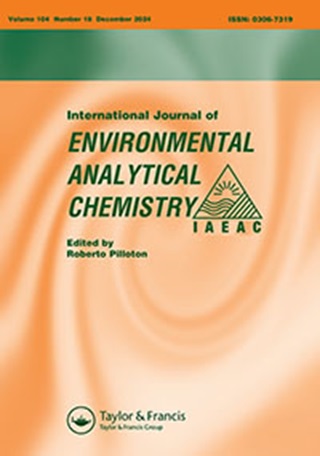高、低本底辐射区环境基质中作为潜在污染物的原始放射性核素的来源、命运和转移——综述
IF 2.5
4区 化学
Q3 CHEMISTRY, ANALYTICAL
International Journal of Environmental Analytical Chemistry
Pub Date : 2023-11-07
DOI:10.1080/03067319.2023.2277891
引用次数: 0
摘要
摘要污染物的来源、归宿和迁移是环境化学研究的热点,主要研究化学物质在土壤和水体中的存在及其影响。在这种情况下,尽量减少污染源和限制污染的产生是实现环境可持续性的关键因素。在过去的几十年里,世界各地的研究人员设计了新的方法来解决与土壤、空气和水体中的主要污染有关的争端。然而,仍有必要解决放射性核素作为污染物的研究兴趣。处理与放射性核素污染有关的问题的第一步将是发展关于放射性核素在自然高本底辐射地区和世界其他地点的积累、传输速率和命运的完整知识和数据库。本综述试图提供这方面的信息,简要介绍了母体放射性核素(238U、232Th、40K)及其子代放射性核素(210Po和210Pb)在各种介质(土壤、沉积物、岩石和水)以及靠近放射性核素污染区域的水生环境食物链中的A.C c、c.r和T.F。它讨论了这些地区关于放射性同位素的分歧,并提请注意它对当地生物群和人口构成的威胁。这些地区的放射性核素浓度超过建议参考水平,将为开展与居民健康影响有关的流行病学研究提供可能的机会。它还将为今后开展旨在为生物多样性拟订补救措施的研究活动铺平道路。作者感谢金奈新学院(自治)动物学部主席、名誉秘书兼通讯员、校长、副校长(学术与行政)P.G.与研究部的机构支持。我们深切感谢新德里印度政府科学和技术部-科学和工程研究委员会(dst -塞族)为该项目提供资金。[ECR/2017/001268,日期:18.03.2019]。披露声明作者未报告潜在的利益冲突。作者的贡献:bharathi Santhanabharathi -概念化和设计,数据管理,Kumara Perumal Pradhoshini -概念化和设计,手稿准备-编写原始手稿,Munawar Suhail Ahmed -数据管理,手稿准备-审查和编辑,Marckasagayam Priyadharshini -手稿准备-审查和编辑,Mohamat Hanifa Shafeeka Parveen -手稿准备-审查和编辑,Lubna Alam -统计分析和数据解释,Ismail Md Mofizur Rahman -统计分析和数据解释,Van Hao Duong -成像分析,Mehraj Ud Din War -表格准备,Mohamed Saiyad Musthafa -手稿的最终验证和批准。数据可用性声明本研究过程中产生或分析的所有数据都包含在这篇发表的文章[及其补充信息文件]中。其他信息资金作者报告没有与本文所述工作相关的资金。本文章由计算机程序翻译,如有差异,请以英文原文为准。
Source, fate and transfer of primordial radionuclides as potential contaminants in environmental matrices of high and low background radiation areas – a critical review
ABSTRACTThe source, fate and transport of pollutants are of typical interest in environmental chemistry, which focuses on the presence and effects of chemicals in soil and water bodies. In this setting, minimising pollutant sources and limiting pollution generation are key factors in achieving environmental sustainability. Over the past few decades, novel approaches were devised by researchers across the world to resolve disputes related to major pollutions in soil, air and water bodies. However, there is still a need to address the research interest in radionuclides as contaminants. The first step in addressing concerns related to radionuclide contamination would be to develop complete knowledge and a database on the accumulation, transport rate, and fate of radionuclides in both natural high background radiation areas and other locations of the world. The current review is an attempt to provide information about this, where it briefs out the A.C, C.R. and T.F of the parental radionuclides (238U, 232Th, 40K) and their progeny nuclides (210Po and 210Pb) in various media (soil, sediments, rock, and water), as well as in the food chains of aquatic environments close to areas contaminated with radionuclides. It discusses the disagreements around radio-isotopes in these regions and draws attention to the threat it poses to the local biota and population. Exceeding concentration of radionuclides than the recommended reference level in such areas shall open up possible opportunity of conducting epidemiological studies related to the health effects of the inhabitants. It shall also pave a way for initiating future research activities destined in formulation of remedial measures for the welfare of biodiversity.KEYWORDS: Radionuclidessedimentsoilwateraquatic biotageochemical transfer AcknowledgmentsThe authors are thankful to the Chairman, Honourable Secretary & Correspondent, Principal, Vice-Principals (Academic & Administration) P.G. & Research Department of Zoology, The New College (Autonomous), Chennai for Institutional support. We profoundly thank Department of Science and Technology – Science and Engineering Research Board (DST-SERB), Government of India, New Delhi for funding the project [File No.: ECR/2017/001268, dated 18.03.2019].Disclosure statementNo potential conflict of interest was reported by the author(s).Author’s contributionBharathi Santhanabharathi - Conceptualisation and design, Data curation, Kumara Perumal Pradhoshini – Conceptualisation and design, Manuscript preparation – writing original manuscript, Munawar Suhail Ahmed – Data curation, Manuscript preparation – review and editing, Marckasagayam Priyadharshini – Manuscript preparation – review and editing, Mohamat Hanifa Shafeeka Parveen – Manuscript preparation – review and editing, Lubna Alam – statistical analysis and data interpretation, Ismail Md Mofizur Rahman – statistical analysis and data interpretation, Van Hao Duong – Imaging analysis, Mehraj Ud Din War – Table preparation, Mohamed Saiyad Musthafa – Final validation and approval of the manuscript.Data availability statementAll data generated or analysed during this study are included in this published article [and its supplementary information files].Additional informationFundingThe author(s) reported there is no funding associated with the work featured in this article.
求助全文
通过发布文献求助,成功后即可免费获取论文全文。
去求助
来源期刊
CiteScore
5.90
自引率
7.70%
发文量
373
审稿时长
4.4 months
期刊介绍:
International Journal of Environmental Analytical Chemistry comprises original research on all aspects of analytical work related to environmental problems. This includes analysis of organic, inorganic and radioactive pollutants in air, water, sediments and biota; and determination of harmful substances, including analytical methods for the investigation of chemical or metabolic breakdown patterns in the environment and in biological samples.
The journal also covers the development of new analytical methods or improvement of existing ones useful for the control and investigation of pollutants or trace amounts of naturally occurring active chemicals in all environmental compartments. Development, modification and automation of instruments and techniques with potential in environment sciences are also part of the journal.
Case studies are also considered, particularly for areas where information is scarce or lacking, providing that reported data is significant and representative, either spatially or temporally, and quality assured. Owing to the interdisciplinary nature of this journal, it will also include topics of interest to researchers in the fields of medical science (health sciences), toxicology, forensic sciences, oceanography, food sciences, biological sciences and other fields that, in one way or another, contribute to the knowledge of our environment and have to make use of analytical chemistry for this purpose.

 求助内容:
求助内容: 应助结果提醒方式:
应助结果提醒方式:


